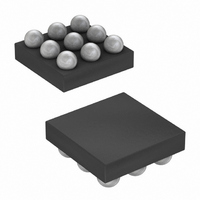MAX9716EBL+TG45 Maxim Integrated Products, MAX9716EBL+TG45 Datasheet - Page 11

MAX9716EBL+TG45
Manufacturer Part Number
MAX9716EBL+TG45
Description
IC AMP AUDIO PWR 1.4W MONO 9UCSP
Manufacturer
Maxim Integrated Products
Type
Class ABr
Datasheet
1.MAX9716ETAT.pdf
(21 pages)
Specifications of MAX9716EBL+TG45
Output Type
1-Channel (Mono)
Max Output Power X Channels @ Load
1.4W x 1 @ 4 Ohm
Voltage - Supply
2.7 V ~ 5.5 V
Features
Depop, Differential Inputs, Shutdown, Thermal Protection
Mounting Type
Surface Mount
Package / Case
9-UCSP®
Lead Free Status / RoHS Status
Lead free / RoHS Compliant
Figure 2. Setting the MAX9716/MAX9717A Gain
External feedback resistors set the gain of the
MAX9716 and MAX9717A. Resistors R
Figure 2) set the gain of the amplifier as follows:
Where A
20kΩ and an R
R
digitally controlled potentiometer to alter the gain under
software control.
The gain of the MAX9717 in a single-ended output
configuration is half the gain when configured as BTL
output. Choose R
MAX9716 and MAX9717A. Gains for the MAX9717B/C/D
are set internally.
C
bias from an incoming signal. The AC-coupling capaci-
tor allows the amplifier to bias the signal to an optimal
DC level. Assuming zero-source impedance, the -3dB
point of the highpass filter is:
Setting f
response of the amplifier. Use capacitors with
dielectrics that have low-voltage coefficients, such as
tantalum or aluminum electrolytic. Capacitors with high-
voltage coefficients, such as ceramics, can increase
distortion at low frequencies.
F
IN
can be either fixed or variable, allowing the use of a
AUDIO
INPUT
and R
V
C
-3dB
IN
IN
is the desired voltage gain. Hence, an R
form a highpass filter that removes the DC
F
R
too high affects the low-frequency
IN
of 20kΩ yields a gain of 2V/V, or 6dB.
f
−
______________________________________________________________________________________
F
3
A
dB
between 10kΩ and 50kΩ for the
V
BIAS
IN+
IN-
=
=
2 π
2
⎛
⎜
⎝
R C
R
MAX9716
R
IN IN
Gain-Setting Resistors
IN
1
F
R
F
⎞
⎟
⎠
Adjustable Gain
Low-Cost, Mono, 1.4W BTL Audio
F
OUT-
OUT+
and R
Input Filter
IN
IN
(see
of
The MAX9717 require output-coupling capacitors to
operate in single-ended (headphone) mode. The out-
put-coupling capacitor blocks the DC component of the
amplifier output, preventing DC current from flowing to
the load. The output capacitor and the load impedance
form a highpass filter with a -3dB point determined by:
As with the input capacitor, choose C
f
Setting f
quency response. Load impedance is a concern when
choosing C
the -3dB point of the output filter. A lower impedance
increases the corner frequency, degrading low-fre-
quency response. Select C
case load/C
response. Select capacitors with low ESR to minimize
resistive losses and optimize power transfer to the load.
The MAX9716 can be configured for a differential input.
The advantage of differential inputs is that any com-
mon-mode noise is attenuated and not passed through
the amplifier. This input improves noise rejection and
provides common-mode rejection (Figure 3). External
components should be closely matched for high
CMRR. Figure 4 shows the MAX9716 configured for a
differential input.
Figure 3. CMRR with Differential Input
-3dB
is well below the lowest frequency of interest.
-3dB
-100
-10
-20
-30
-40
-50
-60
-70
-80
-90
OUT
0
10
OUT
Power Amplifiers
too high affects the amplifier’s low-fre-
COMMON-MODE REJECTION RATIO
. Load impedance can vary, changing
f
−
3
combination yields an adequate
dB
100
Output-Coupling Capacitor
vs. FREQUENCY
=
FREQUENCY (Hz)
2 π
1k
R C
OUT
L OUT
V
R
C
1
RIPPLE
L
BIAS
= 8Ω
Differential Input
such that the worst-
= 1μF
10k
= 200mV
OUT
P-P
100k
such that
11












